
The World Before Adam
Satan’s Kingdom Is Unveiled
The history of life on earth is an extremely important subject, for it gives us the very root understanding of our own origins. We are well aware through Scriptural truth that our origins began with Adam and Eve in the Garden of Eden some 6,000 years ago. Since that time there have been countless generations of people that have been propagated. If we assume a generational period of 30 years — likely longer before the Flood — then there would have been about 200 generations of mankind since Adam’s creation. Billions of people have lived on the earth since the beginning of this aeon, possible10 billion up to the time of the Flood, and today there are over 7 billion souls in all nations across the earth.
 However, the subject of this paper is not to discuss in detail the history of the past 6,000 years, of which we know certain facts. From the creation of Adam until the great Flood relatively little is known, and that knowledge is almost entirely contained in Genesis 1 through 8. Since that time we have an increasing accumulation of historical truth from Genesis 9 through the rest of Genesis, and in the subsequent 65 books of Scripture. Add to that the records we have of the various empires of man through the Babylon, Assyria, Egypt, Persia, China, India, and other nations, and we have quite a colossal compilation of knowledge of our forefathers, especially since the time of Christ. Not all of this history, of course, is totally accurate, since it is the victors of conquests who write and perpetuate the historical record. Even so we have a reasonably complete record of wars and happenings of the major empires since the early Roman Empire.
However, the subject of this paper is not to discuss in detail the history of the past 6,000 years, of which we know certain facts. From the creation of Adam until the great Flood relatively little is known, and that knowledge is almost entirely contained in Genesis 1 through 8. Since that time we have an increasing accumulation of historical truth from Genesis 9 through the rest of Genesis, and in the subsequent 65 books of Scripture. Add to that the records we have of the various empires of man through the Babylon, Assyria, Egypt, Persia, China, India, and other nations, and we have quite a colossal compilation of knowledge of our forefathers, especially since the time of Christ. Not all of this history, of course, is totally accurate, since it is the victors of conquests who write and perpetuate the historical record. Even so we have a reasonably complete record of wars and happenings of the major empires since the early Roman Empire.
In this paper we are going to delve into the murky past before the time of Adam and Eve, before the institution of the Garden of Eden, for there is ample evidence in Scripture, archaeology, and geology to prove there was at least one civilization that existed before Adam. The existence of this civilization will explain a host of enigmatic anomalies discovered in the earth’s strata, and also cast light on some Biblical citations that may have seemed confusing to us in the past, but which make sense when coupled with basic logic and a willingness to avoid the constraints of ossified traditions that claim the entire earth was somehow “spoken into existence” in an instant, as some modern Biblical interpretors have claimed.
The Adamite Creation
Let us take a very brief excursion into the Adamic creation as delineated in Genesis 1 to see just how this creation period was accomplished. I will point out first of all that the Hebrew word for day — yowm — does not refer here to 24 hour days, but rather to a certain undefined time period. It can mean the following:
(a) The period of daylight, as contrasted with nighttime (Genesis 8:22)
(b) A period of 24 hours (Genesis 39:10)
(c) A period of unspecified duration (Genesis 2:3, 4, 17)
(d) A year, when used in the plural form (Exodus 13:10)
Taking point (c) as the proper definition in this case, one can understand the six-day creation scenario as I laid out in my book The Three Edens (Xulon Press, Maitland, Florida, 2011, pages 600-604). I took advantage in this book of the writings of P.J. Wiseman in Clues to Creation in Genesis (Marshall, Morgan, and Scott, London, 1977), which made clear that the 24-hour days refer to the revealing of the creation scheme, which occurred in colophon form. A colophon is attached to the end of a narrative, and includes the title, date, name of the writer, and other literary information. Thus, for instance, it is likely that on day 3, when waters were drained from the land and plants were created, the light from the sun was gradually beginning to increase on the earth’s surface as atmospheric ash and dust settled. By day four, perhaps a year later, the various lights in the heavens — the sun, moon, and stars — now became visible and enabled photosynthesis to occur in its fullness. After all, during the Flood of Noah’s day the waters covered the earth for approximately a year, following a similar scenario as we see in Genesis 1:9-19. I have included a discussion from The Three Edens at the end of this paper for those wanting a more thorough understanding on the matter.
It is highly important to understand, while reading about the creation in Genesis 1, the perspective from which the narrative is given. Verse 2 clearly states, “And the spirit of God was hovering [rachaph, ‘to brood’] over the face of the waters.” God was just above the waters a short distance, so the darkened atmosphere was above him, blocking sunlight from reaching the waters’ surface … thus explaining the “… darkness … on the face of the deep.” Then, as the days and months passed, the atmosphere gradually cleared so that by the third day, perhaps several years later, plants could survive. After a longer passage of time on day six the cattle, beasts, creeping things, and man could be created, now with a fully-developed ecosphere having full sunlight to sustain them (Genesis 1:24-31).
Biblical Evidence of the Pre-Adamic World
Let’s now venture into the main issue of this paper … that there was a civilization upon the earth before Adam was created. Let us first examine some hard Biblical facts.
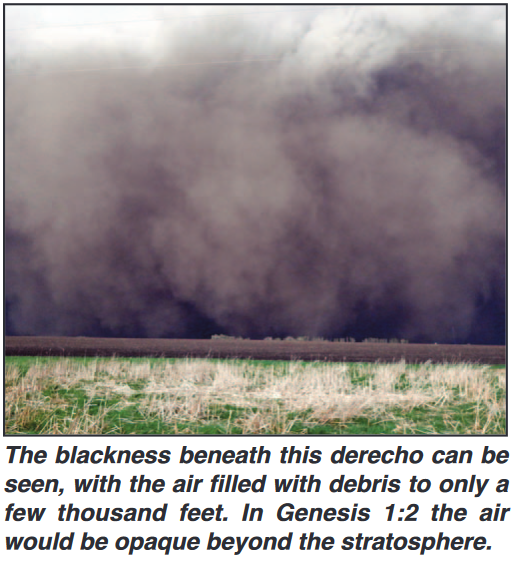 1.The earth was without form [tohuw] and void [bohuw] at the beginning of the Biblical narrative (Genesis 1:2).
1.The earth was without form [tohuw] and void [bohuw] at the beginning of the Biblical narrative (Genesis 1:2).
tohuw, “to lie waste, a desolation (of surface), worthless, in vain.”
bohuw, “empty, vacuity, an indistinguishable ruin.”
The surface of the earth was in utter chaos, without any order or beauty, covered with water, much like in the days of Noah’s Flood but even more chaotic and severe than that event. The atmosphere was loaded with ash, dust, and debris so that sunlight could not penetrate to the earth’s surface. I can understand this quite well, after experiencing a derecho in May of 2022 at my home farm in eastern South Dakota. This derecho — a widespread windstorm — packed 100+ mph winds while it hurtled through the area, kicking up dust and assorted cornstalks and debris from fields. The air suddenly turned black as the winds struck the farmstead with terrific force, threatening to blow out windows, tear off shingles, and push over trees. The fierce winds did remove some shingles and blew over countless tress, but the most memorable part of the storm was the utter blackness of the sky. The darkness lasted for several minutes as my wife and I huddled in the basement. These billows of dust and debris dirtied the sky to perhaps only 10,000 feet (roughly two miles) in altitude. Imagine the total, grinding darkness on the earth’s surface with ash, dust, and debris blocking out the sun to an altitude of perhaps 20 miles or more! The blackness would be total.
No mountaintops were visible above the roiling waters. Whatever had been on the land surface before this devastating flood was totally annihilated, flattened, churned and blended into the mass chaos of rocks and mud that roiled to and fro with the tidal waves of a worldwide ocean cover. The massive power of the seas, which likely had recently received a liberal dose of volcanic ash and debris, and very possibly the rocks and sediment from the near-miss or glancing blow of a planet or huge asteroid, laid down layer after layer of sediments, which, once the wave action had attenuated, hardened into sedimentary rock layers: limestone, sandstone, shale, and slate. Some of these rocks metamorphosed into marble, gneiss, and other rocks through pressure and heat. Solidifying rock layers heaved and buckled, twisted and folded much like the titanic forces on day three of the flodd in Noah’s day — “let the dry land appear” (Genesis 1:9) — forced land surfaces above the water.
Because of the prolonged blackness and lack of sunlight, it is doubtful that any living creature, including plants and fish, could survive the chaos and confusion. Only microorganisms survived the tumult. The massive extinction of all but microscopic life was complete.
But why was the destruction so complete? Only a loving creator God under extraordinary circumstances could justify such annihilation of a lovely ecosphere He had made … and His creations are always good (see Genesis 1:31). There had to be a good reason, a very good reason for this total destruction.
- It is important to note that it would be better to translate the world was in Genesis 1:2 as became. The Hebrew word used here is hayah, meaning “to become, come to pass, come to be.” This directly implies that there was something that existed before this utter destruction. We also have the example of the Flood in Noah’s day, during which a previous civilization was washed away due to its utter wickedness (Genesis 6:5, 11-12). Did not, then, the pre-Adamic period also possibly contain a vast population? It is God’s desire that the earth be inhabited (Isaiah 45:18).
- We should notice that the earth became tohuw because of sin, and sin brings its consequences. Tohuw is translated as waste (Deuteronomy ), without form (Genesis 1:2; Jeremiah 4:23), vain (Isaiah 45:18; I Samuel 12:21), confusion (Isaiah 24:10; 34:11; 41:20), empty (Job 26:7), vanity (Isaiah 40:17, 23; 44:9; 59:4), nothing (Job 6:18; Isaiah 40:17), and wilderness (Job 12:24; Psalm 107:40). Bohuw is translated as void (Jeremiah 4:23) and emptiness (Isaiah 34:11). The complete destruction of the world, a world that must have initially been ordered and beautiful — for the Creator does not desire disorder, ugliness, and confusion — required a new creation, that which took place as revealed in Genesis 1.
- We must remember that darkness and floods are invariably related to judgment. For judgment to occur there had to be a people worthy of judgment and extinction, i.e., having committed such evil that they had to be wiped out … just as did those evil souls who populated the earth before the great Flood of Noah’s day (Genesis 6:5, 11-12). This judgment upon the earth necessitates a people populating the earth before Adam. See the relationship of darkness to judgment in Matthew 8:12; 24:29; Revelation 6:12-17; 8:12; 9:2; 16:10; Isaiah 13:10; Joel 2:30-31; Amos 5:18-20.
- Not to be forgotten is the command for mankind to be fruitful and multiply, and replenish [male, “to fill, fulfill, overflow, ordain”] the earth (Genesis 1:28). Noah was given this same command in Genesis 9:1-2, indicating that the word translated replenish in the King James Version, though translated fill in the New King James Version, in any case indicates a refilling with people. The command implies that the earth was filled with a population of people before the Genesis 1 creation. The activity of creation during this Genesis 1 period ought better be described as a re-creation.
Lucifer’s Realm
- We have direct Biblical evidence that Lucifer existed before Adam was created. How can we say this? The logic is very simple. First notice Ezekiel 28:
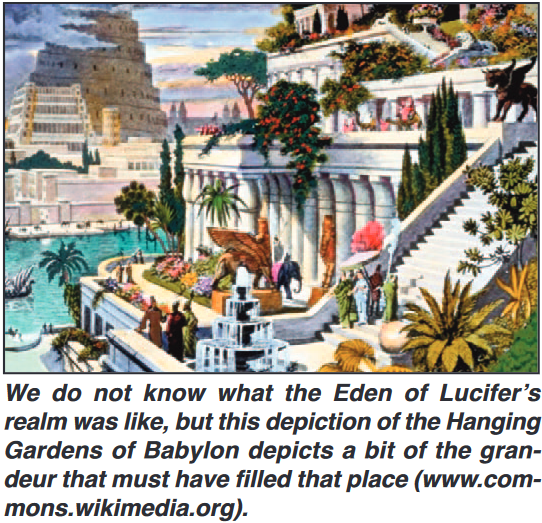 12” Son of man, take up a lamentation for the king of Tyre, and say to him, ‘Thus says the Lord God:
12” Son of man, take up a lamentation for the king of Tyre, and say to him, ‘Thus says the Lord God:
You were the seal of perfection,
Full of wisdom and perfect in beauty.
13 You were in Eden, the garden of God;
Every precious stone was your covering;
The sardius, topaz, and diamond, beryl, onyx, and jasper, sapphire, turquoise, and emerald with gold.
The workmanship of your timbrels and pipes was prepared for you on the day you were created [bara, “create or select”].
14 You were the anointed cherub who covers;
I established you;
You were on the holy mountain of God;
You walked back and forth in the midst of fiery stones.
15 You were perfect in your ways from the day you were created, till iniquity was found in you.
16 By the abundance of your trading you became filled with violence within, and you sinned.
Therefore I cast you as a profane thing out of the mountain of God;
And I destroyed [abad, “to disappear, wander away”] you, O covering cherub, from the midst of the fiery stones.
17 Your heart was lifted up because of your beauty;
You corrupted your wisdom for the sake of your splendor;
I cast you to the ground, I laid you before kings, that they might gaze at you.
18 You defiled your sanctuaries by the multitude of your iniquities,
By the iniquity of your trading;
Therefore I brought fire from your midst; it devoured you,
And I turned you to ashes upon the earth in the sight of all who saw you.’”
The companion Scripture to Ezekiel 28 is Isaiah 14:12-17:
12 “How you are fallen from heaven, O Lucifer, son of the morning!
How you are cut down to the ground, you who weakened the nations!
13 For you have said in your heart, ‘I will ascend into heaven,
I will exalt my throne above the stars of God;
I will also sit on the mount of the congregation on the farthest sides of the north;
14 I will ascend above the heights of the clouds, I will be like the Most High.’
15 Yet you shall be brought down to Sheol, to the lowest depths of the Pit.
16 Those who see you will gaze at you, and consider you saying:
‘Is this the man who made the eath tremble, who shook kingdoms,
17 Who made the world as a wilderness and destroyed its cities,
Who did not open the house of his prisoners?’”
Notice that Lucifer was in “Eden, the Garden of God” (Ezekiel 28:13). This directly implies that at the time he was perfect, well before Genesis 1:2 — for in the Garden of Eden of Adam he was already sinful and the tempter of Eve and Adam (Genesis 3:1-7) — he was in an Edenic environment. This was presumably the very throne of the Most High, for Ezekiel 28:14 states he was in the “mountain of God.” Mountain implies the seat of government, where the fiery stones were (see Daniel 7:9; Ezekiel 1:26-28; 10:1; Exodus 24:10; Revelation 4:2-3, 6).
The Garden of God in Eden was very likely this very same Garden of Eden into which Adam was placed after his creation. It was the perfect environment for people made in God’s image to live, with trees beautiful to look upon, which produced fruit that was good for man’s health; also in the Garden were herbs and other plants (Genesis 1:29; 2:8-9). Was not this the very abode of the Father, the New Jerusalem in all of its grandeur as we read about in Revelation 20?
The Creator would have created an Eden equally as beautiful, productive, and perfect for His servant Lucifer in the pre-Adamic world as He would for Adam in the following aeon. That is His nature: he wishes the very best for His creations, and will support them with every good thing. It is also obvious that, along with this perfect environment, there would be a population of beings that we might be tempted to call “humans.” Whether they were made in the image of Elohim as were Adam and Eve remains a question, though I personally believe they were, since their skeletal remains are identical to Homo sapiens, albeit ususlly larger in size.
Then Lucifer (light-bringer) sinned, and he became Satan (the deceiver). He sinned — missed the mark — by merchandising, or trading [rkullah,”trade or peddle;” from rakal, “to travel for trading”] as we read in Ezekiel 28:16 and 18. It appears that this merchandising is a means by which Lucifer accumulated physical wealth through buying and selling. Then, over time, he used this selfish motivation to control people’s behavior, exalting himself and attempting to force others to follow these pernicious ways even as Cain, Nimrod, and others throughout history have done. Even in the present time wealthy bankers, owners of investment companies, businessmen, and media and entertainment moguls have on their agenda the will to capture the obedience of people around the world. As one example, Blackrock CEO Larry Fink, who owns controlling interest in many huge companies, in 2017 in a New York Times interview stated the following regarding forcing companies to promote DEI (diversity, equity, and inclusion) standards:
“Behaviors are gonna have to change and this is one thing we’re asking companies. You have to force behaviors, and at Blackrock we are forcing behaviors” (www.fox-business.com/politics/blackrock-ceo-slammed-force-behaviors-dei-initiatives).
Is not the very purpose of the mark of the beast to prevent buying and selling except one receives the mark on one’s right hand or forehead (Revelation 13;15-18)? The right hand pictures what you do, and the forehead is the center of one’s will, what you think.
Lucifer cast aside his wisdom and perfection as soon as he decided to accumulate wealth for himself, rather than continuing to maintain and build his position alongside his heavely Father at His throne. After all, he was the “anointed cherub that covers” (Ezekiel 28:14). The slide from perfection into violence, self-centeredness, pride in his beauty, and corruption of his wisdom probably occurred rather rapidly, over a period of a few months or years.
He refused to repent of his evil downward spiral into darkness that soon resulted in his being cast out of the midst of the fiery stones at the Father’s throne. Indeed, we read in Luke 10:18 that Jesus Himself “… saw Satan fall like lightning from heaven,” showing that Christ Himself was at the Father’s throne observing this horrible debacle. This statement about Satan by Jesus directly precedes his telling the 70, who had been sent out to cities in Israel to preach the gospel of the kingdom and to heal the sick, that He had given them authority to cast out demons, trample on serpents and scorpions, and authority “… over all the power of the enemy” (Luke 10:19). Satan had lost all sense of righteousness by his sinning in the pre-Adamic kingdom, and was intent now, after his being cast to earth, upon pestering, harassing, and oppressing the sons of Adam.
We also read of this event in Revelation 9:1-2:
“Then the fifth angel sounded; and I saw a star fallen from heaven to the earth. To him was given the key to the bottomless pit. and he opened the bottomless pit, and smoke arose out of the pit like the smoke of a great furnace. So the sun and the air were darkened because of the smoke of the pit.”
 Once again we read of the casting out of Lucifer to the earth in Revelation 12:7-9:
Once again we read of the casting out of Lucifer to the earth in Revelation 12:7-9:
“And war broke out in heaven: Michael and his angels fought with the dragon [the devil]; and the dragon and his angels fought, but they did not prevail, nor was a place found for them in heaven any longer. So the dragon was cast out, that serpent of old, called the Devil and Satan, who deceives the whole world; he was cast to the earth, and his angels were cast out with him.”
This is the same serpent or dragon that we find tempting Eve in Genesis 3:1. Notice the similarity of meanings for the words in both Hebrew and Greek.
serpent = n’chash, “a snake (from its hiss)”; from nachach, “to hiss, ie. whisper a magic spell.”
dragon = drakon, “a large kind of serpent, so-called because of its keen power of sight (perhaps as supposed to fascinate).”
We also read in Jude 6 that the angels [who followed Satan] did not keep their proper domain [in heaven], but left their own abode. These angels ”He has reserved in everlasting chains under darkness for the judgment of the great day ….” We find this great conflict mentioned yet again in II Peter 2:4, where “… God did not spare the angels who sinned, but cast them down to hell [tartaroo, “the deepest abyss of Hades”] and delivered them into chains of darkness, to be reserved for judgment…”
Apparently there was a huge conflagration when Lucifer was cast out of the City of God. From what is said in Isaiah 14:13-15, Lucifer actually tried to storm the throne of God, but was thrown back and cast out of heaven and down to earth, with Michael and his angelic host battling Lucifer and his angelic army as mentioned in Revelation 12:7-9. It must have been quite a maelstrom, since the eventual result we see in Genesis 1:2 is darkness, chaos, and confusion on the earth as a result of this heavenly conflict which was manifested so intensely on earth once the Eternal decided to send a flood to destroy that civilization. The pre-Adamic Garden of Eden was destroyed by this great flood, even more completely than the world was destroyed by the Flood of Noah’s day. The result: we must contend with Satan and his minions here on the earth today.
G.H. Pember in Earth’s Earliest Ages (Kregel Publications, Grand Rapids, Michigan, 1975, page 54) draws a close connection between Satan’s habitation in the pre-Adamic world with the Garden of Eden in Adam’s day, and the Holy Mountain of God with the Outer Court of the Tabernacle, the Holy Place, and the Holy of Holies of the Tabernacle in the Wilderness.
“He [Lucifer], therefore, appears to have been the great High Priest of his realm, dwelling in a splendid palace of gold and precious stones near to the place of God’s presence; as the Israelitish High Priest resided at Jerusalem in the vicinity of the temple …. Now the analogy between Satan’s office and that which our Lord has already taken upon Himself in part, and will shortly exercise in full [at the resurrection], is so stricking that it is not easiy to avoid the following inference. That Satan abused his high office of prophet, priest, and king, and thus involved the whole of his province in sin [in the pre-Adamic earth], and the earthly part of it, at least, in a ruin to which allusion is made in the second verse of Genesis 1. That, when his [Satan’s] return to obedience had been proved an impossibility … and when no other created being could be found able to restore the confusion, the Lord Jesus Himself came forth from the God head, to take the misused power into His own hands, and to hold it until the rebellion be altogther suppressed, and any trace of it obliterated.”
Pember goes on to say that the government which Christ will take upon His shoulders as King of Kings over all the earth (Revelation 19:16) appears to be identical with the responsibility once committed to Satan (Pember, page 55). Pember then foresees that Christ will reorder the world according to its prophesied perfection during the Millennial reign. Moreover, he sees that the outline of Satan’s pre-Adamic world can be seen by this prophesied future reign of Christ. Pember states,
“For in the Millennium, Christ and His Church, the members of which will then have been made like unto Himself, are to reign in the heavenly places over earth and its inhabitants. So, probably, in remote ages, before the first whisper of rebellion against God, Satan, as the great governing head and the viceroy of the Almightly, assisted by glorious beings of his own nature, ruled over the sinless dwellers upon earth. At the same time he directed the worship of his subjects, and expounded to them the oracles of the all-wise Creator.”
Like myself, Pember does not wish to conjecture exactly how Satan’s evil thoughts and devices were passed down to the angels loyal to him, and to the people who dwelled on the earth at that time. Suffice it to say that the culture would by all odds be similar to conditions on earth before the Flood: “Then the Lord saw that the wickedness of man was great in the earth, and that every intent of the thoughts of his heart was only evil continually” (Genesis 6:5). If the beings had to be destroyed because of sin — sin being transgression of the law (I John 3:4) — then the individuals living as flesh and blood in Lucifer’s kingdom were judged in the same way as we are judged today. That to me says they were made in God’s image, with the same choices of right versus wrong as we must face in this Adamic age.
Unlike in Noah’s day, however, there was apparently not a single righteous person left to carry on the race of man. Perhaps all of the people in that pre-Adamic age had mixed with the genes of the reprobate sons of Elohim, like the sons of Elohim before the Flood of Noah’s day had intermarried with the daughters of men and left only Noah and his family free of genetic contamination with the Nephilim (Genesis 6:1-4, 9). After all, these evil sons of Elohim were very much operative in the pre-Adamic age, even as they were after the re-creation of the earth.
I also see an uncanny likeness of the sons of God in Psalm 45:6-7 with the spirits that existed during the pre-Adamic world. In fact, is it possible that in this Scripture we are seeing a ceremony of sorts where the Father is selecting Jesus Christ to replace Satan as the coming ruler upon the earth … the Father knowing that Adam and Eve — the next in line for rulership on the revitalized, re-created earth — would sin and fall from grace just like Lucifer did before them?
Read these verses in Psalm 45, where Jesus Christ is positively identified as the One who was anointed with the oil of gladness. (See Hebrews 1:8-9 where this connection with Psalm 45 is made clear.)
“Your throne, O God, is forever and ever; a scepter of righteousness is the scepter of Your kingdom. You love righteousness and hate wickedness; therefore God [the Father], Your God, has anointed You [Jesus Christ] with the oil of gladness more than Your companions” (Psalm 45:6-7).
The World That Then Was
Is it possible that Peter’s words in II Peter 3:5-6 also refer to the pre-Adamic deluge which totally destroyed the earth’s ecosystems? Here is what Peter says:
“For this they willingly forget: that by the word of God the heavens were of old, and the earth standing out of water and in the water, by which the world that then existed perished, being flooded with water.”
While this Scripture could be referring to the flood of Noah’s day, it may as well have relevance to the pre-Adamic period, for with both civilizations the earth stood “out of water,” but then perished in a flood.
Geologic Evidence for a Pre-Adamic Garden
Geologists have attempted to assign ages to the various sedimentary strata that are found lying upon much of the earth’s surface. These layers can sometimes extend downward for thousand of feet. Witness the depth of the Grand Canyon, which is comprised entirely of sedimentary rock layers a mile deep. Beneath these layers lie igneous rock, such as granite, gabbro, and diorite, that were formed by the solidification of molten minerals within the earth’s crust.
Geologists and paleontologists usually set the ages of the various rock layers with incredibly ancient dates. The diagram on the next page illustrates the typical times of the formation of strata, which they deem necessary to fit their theory of evolution and the millions of years they presume are required for species to gradually change.
There are three main periods that are used to describe earth’s history of life: the Cenozoic, Mesozoic, and Paleozoic periods. The time periods are described as follows:
Cenozoic Era — 66 million years to the present
Mesozoic Era — 250 million to 66 million years
Paleozoic Era — 540 million to 250 million years
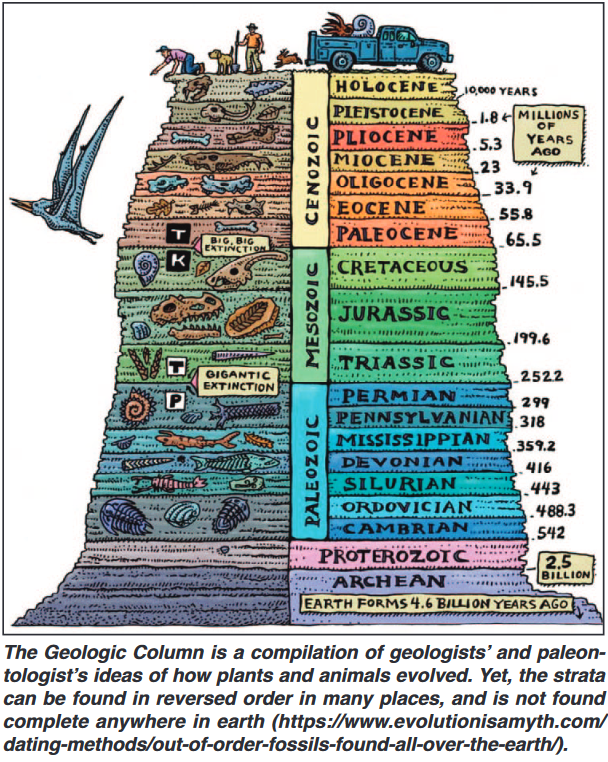 The era before these three is called the Proterozoic Era, when only single-celled organisms supposedly lived, and the Archean Era, going back to the supposed formation of the earth 4.5 billion years ago. The rocks below the Cambrian layer are called Precambrian, dated earlier than 542 million years ago.
The era before these three is called the Proterozoic Era, when only single-celled organisms supposedly lived, and the Archean Era, going back to the supposed formation of the earth 4.5 billion years ago. The rocks below the Cambrian layer are called Precambrian, dated earlier than 542 million years ago.
Each of the three eras and their subdivided epochs have fossils that are supposed to identify their age, so paleontologists search for fossils in a particular layer of sedimentary rock and then date the age of the layer according to the stratigraphy as shown. So, with circular reasoning the sediments are dated according to the fossils they contain, and the fossils are dated according to the strata layer in which they are found, according to agreed-upon ages for specific fossils. This entire dating system is used to support Darwinian evolution: the supposition is that the simplest life forms are found in the lower strata, and over millions of years life forms evolved as evidenced by more complex creatures in upper strata.
It should be understood that various groups of animals, such as dinosaurs, tend to be concentrated in the Jurassic strata, likely because these creatures fled floodwaters and ended up dying enmass in certain elevated locations. Trilobites, cephalopods, clams, and snails could not move and were trapped in lower strata such as Ordovician or Cambrian.
There is a huge problem with this system of dating. That problem centers around the fact that these rock layers are often found in different vertical order throughout the world. As stated by John Read and C.L. Burdick (Fossils, Strata, and Evolution, Scientific-Technical Presentations, Culver City, California, 1979),
“Thus, fossils which are classified as earliest are those identified with the most primitive strata. Life forms considered to have higher development are identified with higher strata. The horse is of late evolutionary age. This fossil sequence is used as ‘proof’ that evolution took place. But this geologic column exists no place in the world as one continuous sequence …. It simply has been pieced together using [William] Smith’s old technique of correlating strata by fossils.”
Some cases of strata being discovered in the wrong order are as follows (Read and Burdick, 1979):
- Glarus in the Swiss Alps. Old Permian rocks are deposited above younger Jurassic rocks, which are above still younger Eocene rocks.
- Empire Mountains, Arizona. Old Permian rocks overlay much younger Cretaceous rocks.
- Crazy Cat Mountain, Texas. Older Ordovician rocks sit on top of much younger Cretaceous rocks.
- Red Rock Canyon, Spring Mountains, Nevada. Lower Cambrian limestone lies upon 370 million years younger Jurassic age sandstone.
- Crowsnest Mountain, Canada. Very old Precambrian limestone rests directly on much younger Cretaceous limestone strata.
- Chief Mountain, Glacier Park, Montana. Precambrian limestone sits upon Cretaceous shale.
- Marias Pass, Glacier Park, Montana. Once again, older Precambrian rocks sit atop much younger Cretaceous shale.
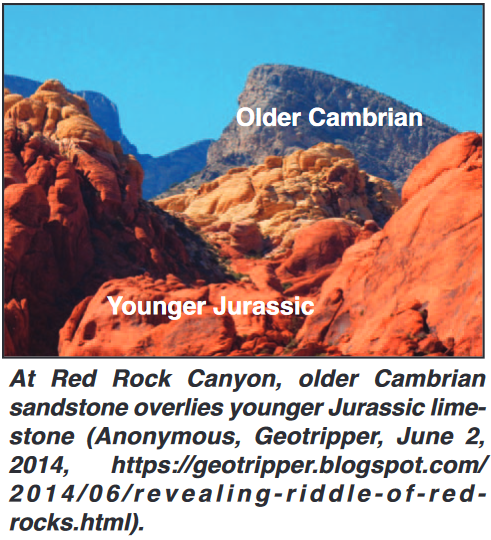 Geologists fight to explain these discrepancies by assuming that the older layer sitting on top of the younger layers were moved there by tremendous forces of over-thrusting. This assumption, however, is very seldom shown to exist! There are no erosional evidences, slickensides, grooving of surfaces, fragmented rock brecia, or pulverized rock gouge between these rock layers that have been dated by their fossils (Read and Burdick, 1979). They lie solidly one atop the other, laid in place in time sequence, and over a very short time period because there is little or no evidence of erosion, which would require many years.
Geologists fight to explain these discrepancies by assuming that the older layer sitting on top of the younger layers were moved there by tremendous forces of over-thrusting. This assumption, however, is very seldom shown to exist! There are no erosional evidences, slickensides, grooving of surfaces, fragmented rock brecia, or pulverized rock gouge between these rock layers that have been dated by their fossils (Read and Burdick, 1979). They lie solidly one atop the other, laid in place in time sequence, and over a very short time period because there is little or no evidence of erosion, which would require many years.
The conclusion to these facts is that nearly all of the strata in the geologic column, even down to some of the Proterozoic and Archean Precambrian layers, and as far upwards as Cenozoic strata such as Eocene rocks (see case 1 in the listing above), had to logically be laid down at roughly the same time … or at least within a rather short time interval, perhaps during weeks, months, or a few years at most. During the time at which the rocks were laid down there was much tilting and warping of the layers, as we see readily in the dipping, twisted, and folded strata in many places throughout the mountain ranges of the world.
We see fossils in sedimentary rocks atop the Rocky Mountains of the western United States, and likewise in the Himalayas of Asia, the Alps and the Caucasus of Europe, and the Andes of South America. All around the world we see layers of sedimentary rocks that had to have initially been deposited horizontally in water, from incredible loads of sand, silt, clay, gravel, and rocks offered by the reworking of previously eroded rocks, volcanic debris, and materials from asteroids or colliding planets. We do not know the sources for all of the sediments. These layers were then tilted, folded, warped, and deformed by huge tectonic forces, creating great fault-block mountains, such as the Rocky Mountains, Himalayas, Alps, and most mountain ranges, or folded mountains such as the Appalachians of the eastern United States.
Once deposited and deformed, forces of water — wave action and huge rivers — would quickly modify the soft deposits, forming river valleys, lakes and lacustrine plains, scablands, and various other geomorphological features. In time the clay, silt, gravel, and other sediments would harden with carbonates and silica and aluminum-rich dissolved compounds, and solidify into rock. Observations on how quickly these forces can occur — over a few weeks, months, and years — have been shown to geologists by the eruption of Mt. St.Helens in Washington in 1980. Here is what Brian Thomas wrote of this great geologic cataclysm (Remembering Mount St. Helens 35 years later, Instutute for Creation Research, May 26, 2015, https://www.icr.org/article/remembering-mount-st-helens-35-years/):
“Mount St. Helens revealed to the world that both thick and thin layering can happen fast. Millions of years are not needed to form sedimentary rock or stratigraphic layering. Sedimentary layers hundreds of feet thick formed within hours during the eruption itself, and then hardened into rock soon after the water drained from them. Could other layered sedimentary rocks in Earth’s crust have formed rapidly? The mountain also provided a clear reason to distrust radioisotope dating. Geologist Steve Austin sampled new rock from atop the mountain that formed in 1986. If the K-Ar radioisotope method really works, then it should have revealed the rock’s true age of only ten years. Instead, three rock “ages” ranged from 340,000 to 2,800,000 years. What other rocks from around the world have been dated incorrectly by following those same questionable age-dating protocols? Because of the Mount St. Helens eruption, scientists know that sedimentary rock layers and steep-walled canyons can form in only hours, rather than millions of years. The documented evidence is undeniable. It also exposes flaws in radioisotope dating. In just the past 35 years, catastrophism has become readily accepted in the geological sciences. How many other Earth surface features will scientists recognize as having formed suddenly or much more recently than previously recognized?”
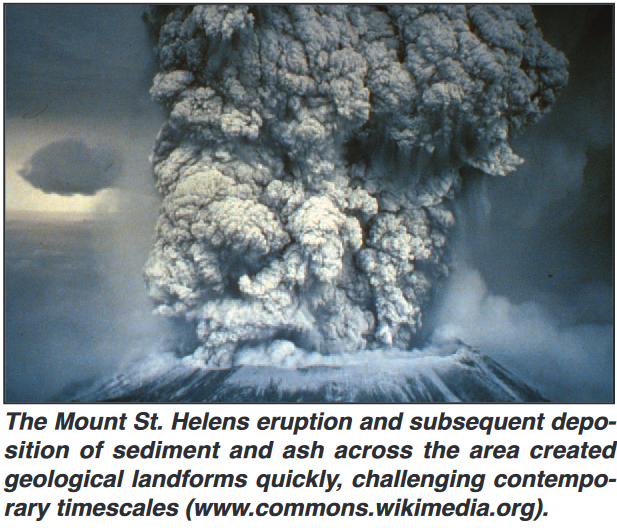 Geologists have also discovered a boundary clay between strata containing unusually high levels of iridium, an element more common in asteroids than in the earth’s crust. This layer is found in several locations across the earth, often associated with the upper Cretaceous strata, and has been correlated with the collision of a huge asteroid, called Chicxulub — about 6 to 9 miles wide — with the earth in the Gulf of Mexico’s Yucatan Peninsula. The 110-mile wide and 12-mile deep crater created by the collision is thought to have cause incredible disruptions to the earth’s ecosphere, including a global winter — from dust thrown into the atmosphere that blocked sunlight and stopped photosynthesis — acidification of oceans, and long-term climate changes (Anonymous, Chicxulub crater, https://en.wikipedia.org/wiki/Chicxulub_crater).
Geologists have also discovered a boundary clay between strata containing unusually high levels of iridium, an element more common in asteroids than in the earth’s crust. This layer is found in several locations across the earth, often associated with the upper Cretaceous strata, and has been correlated with the collision of a huge asteroid, called Chicxulub — about 6 to 9 miles wide — with the earth in the Gulf of Mexico’s Yucatan Peninsula. The 110-mile wide and 12-mile deep crater created by the collision is thought to have cause incredible disruptions to the earth’s ecosphere, including a global winter — from dust thrown into the atmosphere that blocked sunlight and stopped photosynthesis — acidification of oceans, and long-term climate changes (Anonymous, Chicxulub crater, https://en.wikipedia.org/wiki/Chicxulub_crater).
This led to what is termed the K-Pg extinction, wherein dinosaurs, birds, lizards, insects, plankton, sharks, fish, mollusks, and other families and genera of plant and animal life were destroyed. Officially the geologists claim that 75% or more of all species on earth vanished, but likely all life was squelched by this and other conflagrations of this time period (Cretaceous-Paleogene extinction event, https://en.wikipedia. org/wiki/Cretaceous–Paleogene_extinction_event).
Considering all of the evidence at hand — that any of the geologic strata can be reordered through the Cenozoic, Mesozoic, and Paleozoic Eras, that awesome disruptions on the earth such as the Chicxulub Asteroid occurred during the laying down of these strata (including the iridium layer), that there was the possible near-miss of a rogue planet at this time (see Zechariah Sitchin, The 12th Planet, Stein and Day, New York, 1976), and that there were likely numerous volcanic eruptions at this time to add to the mayhem — the message of the geologic column is that there was a tremendous upheaval of the earth’s surface in the pre-Adamic world which annihilated life and terrain, with water being the chief agent which laid down layer after layer of sediments. since the various layers can be reversed and reordered throughout all three supposed eras of time. These strata that have been deposited quickly at Mount St. Helens provide evidence that the strata deposition following Lucifer’s rebellion could have occurred over a relatively short period of time, and can be directly attributed to the devastation that the Eternal reigned upon the earth at that time! Thus, the figure shown here illustrates that potential reality.
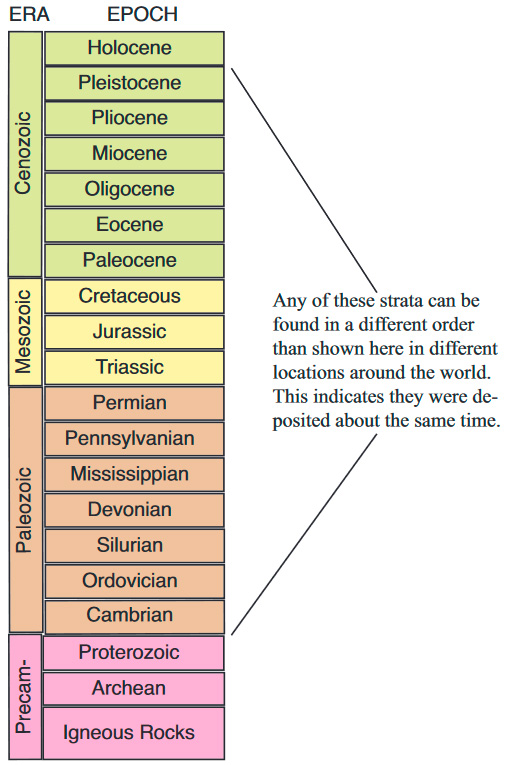 The one exception to this scenario is the very top strata, called the Holocene Epoch This period is part of the Quaternary Period, following the Pleistocene Epoch. Geologists consider the Holocene Epoch to have begun from 6,000 to 12,000 years ago (R. Fairbridge and L. Agenbroad, Holocene Epoch, Britannica Online Encyclopedia, December 7, 2023, https://www.britannica.com/ science/Holocene-Epoch). Now we are getting into the time frame that is closer to the time of the Flood of Noah’s day, which was likely 2347-2348 B.C., or 4,372 years ago (James Bullinger, The Companion Bible, Lowe and Norfolk, Great Britain, 1974, Appendix 50).
The one exception to this scenario is the very top strata, called the Holocene Epoch This period is part of the Quaternary Period, following the Pleistocene Epoch. Geologists consider the Holocene Epoch to have begun from 6,000 to 12,000 years ago (R. Fairbridge and L. Agenbroad, Holocene Epoch, Britannica Online Encyclopedia, December 7, 2023, https://www.britannica.com/ science/Holocene-Epoch). Now we are getting into the time frame that is closer to the time of the Flood of Noah’s day, which was likely 2347-2348 B.C., or 4,372 years ago (James Bullinger, The Companion Bible, Lowe and Norfolk, Great Britain, 1974, Appendix 50).
As Fairbridge and Agenbroad state, the Holocene Epoch contains sediments, both continental and marine, that cover the largest area of the globe of any epoch in the geologic record. It is also an age recognized as corresponding to the history of mankind. This source states, “… the Holocene remains the chronological framework for human history. Archaeologists use it as the time standard against which they trace the development of early civilizations.”
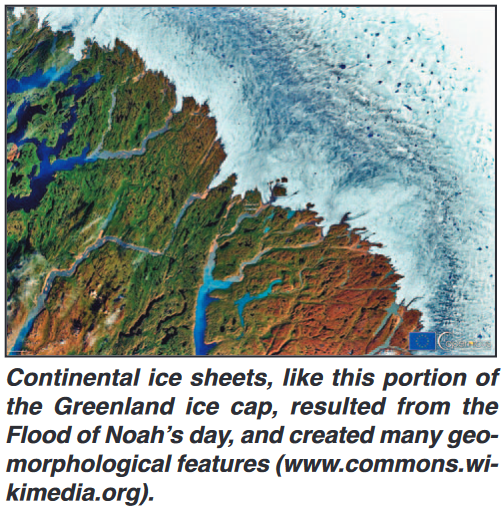 Logic thus suggests that the Holocene Epoch corresponds to the age of man following the great Flood of Noah’s day. That Flood would have spread sediments across the earth’s surface, while not disturbing the rock strata beneath. Moreover, ice and frigid winds would have descended from the disintegrating water canopy in polar regions, quick-freezing mammoths, woolly rhinoceroses, cave lions, bison, squirrels, and bears as they are found today in the permafrost of Alaska and Siberia (A. Grisdale, Frozen in time: 10 prehistoric animals found trapped in ice, Livescience, May 24, 2023, https://www.livescience.com/5-prehistoric-frozen-creatures.html).
Logic thus suggests that the Holocene Epoch corresponds to the age of man following the great Flood of Noah’s day. That Flood would have spread sediments across the earth’s surface, while not disturbing the rock strata beneath. Moreover, ice and frigid winds would have descended from the disintegrating water canopy in polar regions, quick-freezing mammoths, woolly rhinoceroses, cave lions, bison, squirrels, and bears as they are found today in the permafrost of Alaska and Siberia (A. Grisdale, Frozen in time: 10 prehistoric animals found trapped in ice, Livescience, May 24, 2023, https://www.livescience.com/5-prehistoric-frozen-creatures.html).
Glaciers of continental extent would have formed over huge sections of northern and central North America and Asia, creating the eskers, moraines, drumlins, glacial lakebeds, and other evidences of glaciation that have produced the highly mineralized soils and countless lakes and sloughs across the Northern Prairies and Upper Midwest of the United States and Canada. This is called the Prairie Pothole region. The massive water flows across middle North America would have formed the Missouri, Ohio, and Mississippi River Valleys, glacial Lake Agassiz, Lake Bonneville, and other water-sculpted features across the United States.
The Flood of Noah’s day had to be much less severe than was the terrifically destructive flood that resulted in the absolute tohuw and bohuw that we see in Genesis 1:2. Nor was the atmosphere completely darkened during Noah’s flood as it was during the pre-Adamic flood, wherein no chlorophyll-producing plants survived; there was total darkness on the face of the deep, making photosynthesis for plants and plankton, algae and cyanobacteria impossible.
In contrast, during the flood of Noah’s day plants did survive, such as olive trees; the dove brought olives leaves to Noah (Genesis 8:11). Yet, there was wave action enough, and stream action enough once the mountains and hills rose, to produce the surface geomorphological features we see today: plains, valleys, hills, and mountain features, rivers and creeks, and so forth. The land had been fairly level from Eden to the Flood, after the Eternal had prepared the earth for habitation during the creation week (Genesis 1). He caused the dry land to appear above the water through gigantic tectonic forces (Genesis 1:9-10), and the water then cascaded from the lifeless land to form lakes, streams, and seas.

However, the turbulence and total chaos experienced during the pre-Adamic cataclysm was never approached while Noah, his wife, his three sons and their wives, and the animals and birds aboard the ark, waited for a year for the waters to subside. (See Genesis 7, 8, and 9, and my book The Three Edens, Xulon Press, Maitland, Florida, 2011). A catastrophic destruction of the earth as before the days of Adam would have sunk the ark with the violent asteroid and meteoric strikes, the possible close pass of a planet, volcanic eruptions, and the awesome forces that laid down thousands of feet of sediment in places upon the earth. By comparison, Holocene deposits, those presumed to be deposited during Noah’s Flood, are generally only tens to hundreds of feet deep.
Ancient Bones and Artifacts
With an understanding that the geologic column was deposited during the destruction of Lucifer’s evil realm, then we can be assured that the fossil evidence of dinosaurs, pterodactyls, sloths, saber-toothed tigers, trilobites, ammonites, cephalopods, giant cycads, and other extinct plants and animals give evidence of life forms in the pre-Adamic world. What, then, should we say about skeletons and artifacts of civilization that have been unearthed in these ancient strata. Let us first look at a few reports of human skeletons and footprints in William Corliss’ Ancient Man: a Handbook of Puzzling Artifacts (The Sourcebook Project, Glen Arm, Maryland, 1978; items 1 to 7) and other sources.
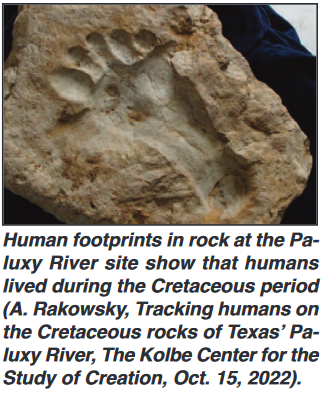
- Human footprints in the secondary limestone of the Mississippi Valley (Schoolcraft, American Journal of Science, 1822).
- Human footprints in stratified rock (Hubbell, Popular Science Monthly, 1882).
- Ancient human footprints, pressed into volcanic ash (Barnaby, Nature, 1975).
- Human teeth in decomposing sandstone (Barnes, Desert Magazine, 1975).
- Fossil parts of a human skull in hard rock (Anonymous, American Naturalist, 1884).
- Ancient human skull found at 153 feet in a shaft through consolidated volcanic ash (B.W.H., American Journal of Science, 1866).
- Human skelton in limestone near Lansing, Kansas (Upham, American Anthropologist, 1902).
- Bones of a man found in a coal bed capped by two feet of slate rock, 90 feet below the surface, in Pennsylvanian Strata (M. Cremo and R. Thompson, Forbidden Archeology, Bhaktivedanta Institute, San Diego, California, 1993; from The Geologist, 1862).
- Fossil footprints in the Upper Carboniferous layer of the Pennsylvanian epoch (Cremo and Thompson, 1993).
- Fossil human footprint in Jurassic rock next to the footprint of a giant three-toed dinosaur (Cremo and Thompson, 1993; from The Moscow News, 1983).
- Large fossil human footprints alongside dinosaur footprints in the Paluxy River near Glen Rose, Texas, in Cretaceous rock. (These have been extensively reported, such as in J. Farlow, et. al., Dinosaur footprints from the Glen Rose Formation
- [Paluxy River, Dinosaur Valley State Park, Somervell County Texas], www.paleo.cc/paluxy/2015-SVP-Farlow-Kuban-et-al.pdf).
- Flowering plants in Precambrian strata. Pollen fossils, evidence of flowering plants preexisting to spread the pollen, were found in Precambrian strata. Flowering plants were thought to first have evolved 160 million years ago; however, the Precambrian strata is supposed as being as old as 4.6 billion years old but no less than 550 million years ago according to Encyclopedia Britannica (Anonymous, Fossils reveal “out of order” evolution, Evolutionary Myths, https://www.evolutionisamyth.com/dating-methods/out-of-order-fossils-found-all-over-the-earth/).
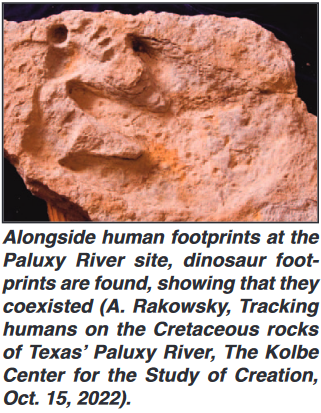 Here are some instances of ancient artifacts found in rock strata, some of which are in Corliss (1978).
Here are some instances of ancient artifacts found in rock strata, some of which are in Corliss (1978).
- A nail found embedded in a block of sandstone (Brewster, Report of the British Association, 1844).
- A molded metallic object found in a chalk bed (Anonymous, INFO Journal, 1969).
- A thimble found in coal (Adams, American Antiquarian, 1883).
- An exquisitely designed metallic object released in the blasting of hard rock (Anonymous, Scientific American 1852).
- Stone mortars in white gravels of Pliocene age in the Sierra Nevada foot hills (Skertchly, Anthropological Institute Journal, 1888).
- A cast iron pot found in coal of Pennsylvanian age at Thomas, Oklahoma (Rush, The Creation Research Society Quarterly, 1971).
- A brass bell found in coal of Pennsylvanian age in Upshur County, West Virginia (www.genesispark.com/exhibits/evidence/paleontological/artifacts/bell/).
- A metal hammer with part of a wooden handle found in a chunk of Cretaceous-age rock, at London, Texas (www.genesispark.com/exhibits/evidence/paleontological/artifacts/hammer).
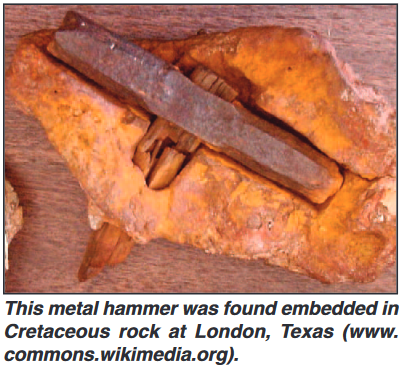 The presence of these human bones and various artifacts of civilization in rock status, even as far back as the Paleozoic era, reveals that a civilization existed before the darkness, chaos, and tumult as viewed by the Eternal in Genesis 1:2. Since these fossilized humans and artifacts occurred in strata that geologists have supposed to be over 300 million years old, then we can be certain that their dating system of these rocks is erroneous, and their construct of the geologic column in support of evolution, is false. These fossils and artifacts reveal that the entire geologic column below the Holocene layer can be placed in various orders. The order of strata that has been constructed, as stated before, is to be found nowhere in the world in a complete set; the column has been created based upon evolutionary theory — i.e., “simplest” life forms in the lower strata and more “complex” forms higher up — with a rejection of any thought that, during rising floodwaters, more mobile creatures like dinosaurs, saber-toothed tigers, and others would scramble to higher ground, to be swept to their graves and covered duing successive cataclysmic tidal waves, and asteroid and meteor collisions.
The presence of these human bones and various artifacts of civilization in rock status, even as far back as the Paleozoic era, reveals that a civilization existed before the darkness, chaos, and tumult as viewed by the Eternal in Genesis 1:2. Since these fossilized humans and artifacts occurred in strata that geologists have supposed to be over 300 million years old, then we can be certain that their dating system of these rocks is erroneous, and their construct of the geologic column in support of evolution, is false. These fossils and artifacts reveal that the entire geologic column below the Holocene layer can be placed in various orders. The order of strata that has been constructed, as stated before, is to be found nowhere in the world in a complete set; the column has been created based upon evolutionary theory — i.e., “simplest” life forms in the lower strata and more “complex” forms higher up — with a rejection of any thought that, during rising floodwaters, more mobile creatures like dinosaurs, saber-toothed tigers, and others would scramble to higher ground, to be swept to their graves and covered duing successive cataclysmic tidal waves, and asteroid and meteor collisions.
As to the correct time-scale of the pre-Adamic flood, there are no sure ways to determine such times since radiocarbon dating, and other forms of radioisotope dating, cannot be trusted. The misconception that radiometric dating can supply “absolute ages” in millions of years with certainty is challenged by Steven Austin in an Institute of Creation Research article (S. Austin, Ten misconceptions about the geologic column, Institute of Creation Research, November 1, 1984).
“Geologists and geochronologists assert that radiometric dating verifies that individual strata systems and their strata are millions of years old. When asked to document the most reliable radiometric age dates, geologists usually point to isochron and concordia plots which employ multiple isotopic analyses, which they claim will remove the effect of original ‘contaminants’ and display the ‘age’ of a rock in graphical form. However, we find geologists often reporting isochron plots which are discordant with the accepted ‘ages’ of strata systems. Frequently, these discordant isochron plots ‘date’ strata systems much older than even the accepted old ages customarily assigned to the systems of the geologic column. Geologists should be asking which, if any, of the isochron plots should be accepted as ‘absolute ages,’ and if the discordances do not falsify the assumptions upon which radiometric dating is based. Geologists need to consider radiometric methods which indicate ages of thousands of years for strata systems, as well as general indicators supporting young age.”
Moreover, a recent article in a major geology journal admits that modern geological dating systems rest on questionable assumptions (D. Coppedge, Assumptions distort geological dating, Creation-Evolution Headlines, July 17, 1023, https://crev.info/2023/07/assumptions-distort-geological-dating/).
To add to the distress that supporters of the accepted geologic time scale must face in light of growing scientific knowledge, note the discovery of stretchy, lifelike tissue in the bone marrow of a fractured Tyrannosaurus rex thighbone.
“Ever since Mary Higby Schweitzer peeked inside the fractured thighbone of a Tyrannosaurus rex, the introverted scientist’s life hasn’t been the same. Neither has the field of paleontology. Two years ago, Schweitzer gazed through a microscope in her laboratory at North Carolina State University and saw lifelike tissue that had no business inhabiting a fossilized dinosaur skeleton: fibrous matrix, stretchy like a wet scab on human skin; what appeared to be supple bone cells, their three-dimensional shapes intact; and translucent blood vessels that looked as if they could have come straight from an ostrich at the zoo. By all the rules of paleontology, such traces of life should have long since drained from the bones. It’s a matter of faith among scientists that soft tissue can survive at most for a few tens of thousands of years, not the 65 million since T. rex walked what’s now the Hell Creek Formation in Montana” (B. Yeoman, Schweitzer’s dangerous discovery, The Sciences, April 27, 2006, https://www.discovermagazine.com/the-sciences/schweitzers-dangerous-discovery).
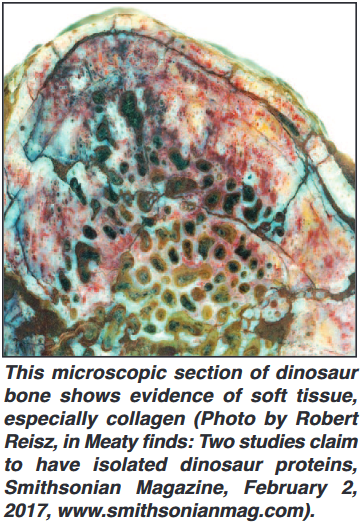 Conventional wisdom among paleontologists says that when a dinosaur dies and become fossilized, its soft tissues do not survive. All of the organic tissues are replaced by minerals, usually within a few weeks or months. The fact that paleontologists have found soft tissue within the bones of a dinosaur speaks clearly that these huge creatures were buried and fossilized not so long ago … not 68 million years ago. Dr. Schwitzer found that the bone marrow tissue was largely intact, still transparent and pliable, and interior structures resembled blood vessels and even osteocytes (bone building cells), plus other organic features (Anonymous, NC State paleontologist discovers soft tissue in dinosaur bones, Science Daily, March 25, 2005, https://www.sciencedaily.com/releases/2005/03/050325100541.htm).
Conventional wisdom among paleontologists says that when a dinosaur dies and become fossilized, its soft tissues do not survive. All of the organic tissues are replaced by minerals, usually within a few weeks or months. The fact that paleontologists have found soft tissue within the bones of a dinosaur speaks clearly that these huge creatures were buried and fossilized not so long ago … not 68 million years ago. Dr. Schwitzer found that the bone marrow tissue was largely intact, still transparent and pliable, and interior structures resembled blood vessels and even osteocytes (bone building cells), plus other organic features (Anonymous, NC State paleontologist discovers soft tissue in dinosaur bones, Science Daily, March 25, 2005, https://www.sciencedaily.com/releases/2005/03/050325100541.htm).
A recent report by Michael Snyder states some addition facts and views on the soft tissue discoveries in ancient fossils around the world (Scientists have been making amazing DNA and soft tissue discoveries that should completely alter how we view the ancient hostory of Earth, Discern Report, Jamuary 8, 2024, https://discernreport.com/scientists-have-been-making-amazing-dna-and-soft-tissue-discoveries-that-should- completely-alter-how-we-view-the-ancient-history-of-earth/).
“There is no possible way that dinosaur bones that are millions upon millions of years old are supposed to contain soft tissues. But they do. In fact, about a decade ago it was being reported that a fossil bed in China that was being hailed as “Jurassic Park” contained the greatest dinosaur soft tissue discoveries ever recorded. According to the Daily Mail, “nearly-complete skeletons” had been discovered that even included skin and feathers.
“Fossils include complete or nearly-complete skeletons associated with preserved soft tissues such as feathers, fur, skin or even, in some of the salamanders, external gills. One is the feathered dinosaur Epidexipteryx, whose soft tissues have been revealed by the use of ultraviolet light scanners. A fossil of the salamander Chunerpeton shows not only the preserved skeleton but also its skin and external gills. If you believe that those specimens really are millions upon millions of years old, how can you explain that?
“Since 1991, there have been more than 100 similar soft tissue discoveries. All this to say, soft tissues have been found in dinosaur or ‘dinosaur era’ (according to the evolutionary timeline) creatures now well over 100 times. These have been found in many different types of organisms ranging from dinosaurs to mammals, birds, plants, reptiles, amphibians, clams, insects and other arthropods, sponges, and worm fossils. Not only that, but they have also been found all over the world — from China to Mongolia to Russia, Madagascar, Europe, the UK, and all over North and South America. Which means they have been exposed to a wide variety of environmental conditions—cold, hot, wet, and dry.
“And even further, they have been found throughout the fossil record, from the Cambrian to the Triassic, Jurassic, and Cretaceous periods. And they’ve been found at all different levels—the oldest being a marine worm claimed to be 551 million years old! All over the world, soft tissues are being found in dinosaur fossils. If those fossils are thousands of years old, that would be possible, but it should not be possible if they are millions of years old. And when we carbon date dinosaur bones, those bones tell us the exact same thing.”
Some brave scientists claim that organic molecules can be preserved beyond 100,000 years, but this claim is totally unproven — just a guess. I believe that this dinosaur tissue evidence shows that these behemoths lived within a few thousand years before Adam. Coupled with the fact that human and dinosaur tracks have been found together in fossilized strata, then it is plausible to presume that this pre-Adamic society, in which dinosaurs and people lived together, occurred no longer than 10,000 years before Adam.
I also believe that these denizens of the Luciferian world were not a part of the original creation that Elohim placed on the earth. Their apparent fierce nature, as evidenced by their size, teeth, and overall appearance, more typically approaches the character of the Serpent himself, Satan the Devil. Did he not manipulate the genetics of the creation to create monsters out of originally peaceful and lovable creatures? He certainly had the intelligence to do so as evidenced by how he has motivated geneticists in the present age to alter genetics in various ways. Techniques have been devised to insert, delete, and modify DNA at multiple levels, ranging from a single base pair in a specific gene to entire genes. The cells to be modified are gently opened to extract the gene(s), the gene(s) is isolated, and then modified before being inserted into the host genome. Various techniques, such as TALE (transcription activator-like effectors), have been used since 2009 to edit genes. In 2011 a major breakthrough in gene editing occurred when the CRISPR/Cas (clustered regularly interspaced short palindromic repeat/CRISPR associated protein) method was developed (Anonymous, Genetic engineering techniques, www.wikipedia.org/wiki/genetics engineering-techniques). This method is effective at gene disruption, and could be similar to a system used by Satan to convert species of animals to his own design.
There Was a World Before Adam
I have shown through Biblical and geologic evidence that there existed a society of human beings on the earth before the time of the re-creation of the earth’s ecosphere, as revealed in Genesis 1. Genesis 1:2 reveals a world in utter chaos, confusion, and darkness, with the Father hovering above the surface of the floodwaters covering the earth. This destruction of a previous civilization living in a veritable Garden of Eden was so complete that not even plants survived the darkness, which made photosynthesis — that marvelous conversion of sunlight energy to biologic reality — entirely absent.
A beautiful, productive Garden on earth and its people, presided over by a perfect and sinless Lucifer — a magnificent son of God — was at some point in time turned into a society of avarice, pride, and rapine once Lucifer began merchandising and accumulating things for himself. Unrepentant and filled with envy, he stormed the throne of God the Father in an attempt to take over rulership of the heavenly Zion, but was repulsed by Michael and his army of righteous angels, and thrown back to earth where he and his demonic minions continue to provoke evil and suffering to this very day (I Peter 5:8).
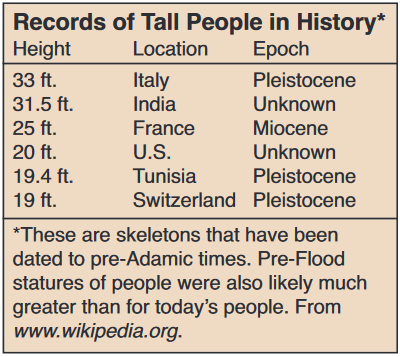 The evidence for the reality of this great portion of earth’s history is found in Scripture, especially Isaiah 14 and Ezekiel 28, the “Satan chapters,” besides other places where this great battle in heaven and the subsequent annihilation of that first Eden on earth are alluded to. Many other theologians also concur with this great neglected segment of history, which is also revealed through the skeletons and artifacts of that pre-Adamic civilization preserved in stone. The strata laid down during that huge destruction of the ecosphere, after Lucifer had polluted his world with lawlessness, was in many ways similar to the great Flood of Noah’s day, though on a much grander scale, since the sediments deposited by the floodwaters, asteroid, volcanoes, and possibly even a near collision with a planet are in some areas thousands of feet deep. Truly the earth was tohuw and bohuw after this destruction by the Almighty was complete.
The evidence for the reality of this great portion of earth’s history is found in Scripture, especially Isaiah 14 and Ezekiel 28, the “Satan chapters,” besides other places where this great battle in heaven and the subsequent annihilation of that first Eden on earth are alluded to. Many other theologians also concur with this great neglected segment of history, which is also revealed through the skeletons and artifacts of that pre-Adamic civilization preserved in stone. The strata laid down during that huge destruction of the ecosphere, after Lucifer had polluted his world with lawlessness, was in many ways similar to the great Flood of Noah’s day, though on a much grander scale, since the sediments deposited by the floodwaters, asteroid, volcanoes, and possibly even a near collision with a planet are in some areas thousands of feet deep. Truly the earth was tohuw and bohuw after this destruction by the Almighty was complete.
It is not understood exactly who these individuals were in this pre-Adamic society, but I conjecture that they were much like us, though larger in stature because of the high oxygen and carbon dioxide content of the atmosphere, greater air density, the more perfect quality of solar radiation that shone through a water canopy, and also lower gravitational pull than we experience today. Research has shown that the larger dinosaurs, if they were to exist with today’s gravity, would not be able to even stand up, much less hold up their long necks like Brontosaurus and certain other dinosaurs (P. Huyghe and D. Stach, Dinosaurs and the gravity problem, The Anomalist, ed. by P. Huyghe and D. Stacy, 1994, 72450.1305@compuserve.com). I propose that, like in the pre-Flood days, the sons of God — of which Lucifer was one — came into the daughters of men and bore giants of them; these are the Nephilim as they are called before the Flood, which genes contaminated the entire human genome except for Noah and his family (Genesis 6:9)
History has a way of repeating itself, for as Solomon wrote,
“That which has been is what will be,
That which is done is what will be done,
And there is nothing new under the sun.
Is there anything of which it may be said, ‘See, this is new’?
It has already been in ancient times before us” (Ecclesiastes 1:9-10).
One might ask the question, “So what? What difference does it make if I understand there was a pre-Adamic world with Lucifer in charge, who fell into sin, which led to the destruction of that world? I have a life in this world; isn’t that good enough?”
Let me say this in response. We need to understand the great deceptive power of Satan the Devil, and his capability to deceive all nations, and if allowed, even the very elect (Revelation 12:9; Matthew 24:24). Understanding Satan’s fall from perfection in the pre-Adamic world, and the incredible destruction it made to the entire earth — including to the precious people on it — should help alert us to the imperative need to resist this great evil being, who is prowling around the world today seeking whomever he may devour (I Peter 5:8), especially those of us who have been called into the Truth. We must not underestimate his power … at the same time that we appreciate the much greater power our heavenly Father and Jesus Christ possess to repel this evil being. This should be a catalyst for us to cling mightily to our great God and to our elder brother Jesus Christ, who protect us from the onslaught of the evil forces that Satan might unleash against us.
“If it had not been the Lord who was on our side, let Israel now say — if it had not been the Lord who was on our side, when men rose up against us, then they would have swallowed us alive, when their wrath was kindled against us; then the waters would have overwhelmed us, the stream would have gone over our soul; then the swollen waters would have gone over our soul. Blessed be the Lord, who has not given us as prey to their teeth. Our soul has escaped as a bird from the snare of the fowlers; the snare is broken, and we have escaped. Our help is in the name of the Lord, Who made heaven and earth” (Psalm 124:1-8).
The Days of Genesis 1: What Were They?
Extracted from pages 600 to 604 of The Three Edens (Paul W. Syltie, Xulon Press, Maitland, Florida, 2011)
Much controversy exists as to the nature of the creation — actually a recreation, revealed in Genesis 1 and 2. Some say that the days were each 24 hours long and that matter, living creatures, and plants came into being instantaneously, or at least over a very short time (less than a day). Not to deny that Elohim is capable of performing whatever feats He wishes, for He is a limitless God, there is strong evidence that Elohim worked through the natural, created laws of physics, chemistry, and biology to remake the world in six time periods (yom), as will be discussed here. There is no doubting of the Scripture, only questions surrounding the meaning of the word “day” and how exactly God did His work.
A most excellent book by P. J. Wiseman (Clues to Creation in Genesis, Marshall, Morgan, and Scott, London, England, 1977) emphasizes that the literary structure of Genesis is akin to well-attested ancient literary methods. This view is in sharp contrast to the subjective view on creation purported by J. Wellhausen, the Institute for Creation Research, and others who advocate the “Documentary Hypothesis,” and claim, for the most part, that 24 hours was meant by the “days” in the story.
The essence of Wiseman’s creation hypothesis, one that no critical review of his main thesis has yet contradicted, is that colophons provide the key to understanding the book’s literary structure. Many colophons have been discovered among the cuneiform texts found in Babylon, and have been published, for example, in H. Hunger’s Babyloroische und Assyriscle Kolophone (1968), and in E. Leichty’s The Colophon in Studies Presented to A. L. Oppenheim (1964). These sources substantiate that this scribal device is the key to elucidating the documents that compose Genesis.
- J. Wiseman summarizes his major points as follows:
(1) The six “days” divided from each other by an evening and morning do not refer to the time occupied by God in His acts and the duration of the processes of Creation.
(2) The six days refer to the time occupied in revealing to man the account of Creation.
(3) God rested (literally “ceased”) on the seventh day, not for His own sake but for man’s sake, and because this revelation about Creation was finished on the sixth day, not because on the day (or period) the creation of the world was finished.
(4) The narrative of Creation was probably written on six tablets. Later, it also appears to have become the custom in Babylonia to write the story of Creation on six tablets.
(5) There is good and sufficient evidence to show that the first page of the Bible is the oldest document that has come down to us.
Genesis 2:1-4 is a colophon, a customary addition to the end of a narrative written on clay tablets, giving information regarding the “title” of a tablet or series of tablets, the date when written, the name of the writer, and other literary information. Thus we read,
“Thus the heavens and the earth, and all the host of them, were finished. And on the seventh day God ended His work which He had done, and He rested on the seventh day from all His work which He had done. Then God blessed the seventh day and sanctified it, because in it He rested from all His work which God had created and made. This is the history of the heavens and the earth when they were created, in the day that the Lord God made the earth and the heavens.”
The framework of Genesis 1 reveals remarkable parallelisms that break the chapter into three sections:
Formation of heaven and earth Furnishing of the void of verse 2
- Light 4. Lights
Separating the light from the darkness, Sun, moon, and stars to divide the day from
effecting day and night the night, and for seasons and days and years
- Water and atmosphere 5. Water and atmosphere
Atmosphere separating the waters Life in the water (fish, etc.)
below from those above Life in the atmosphere (birds)
- Land and green vegetation 6. Land, green vegetation, man
(a) Land (a) Land animals and man
(b) Green vegetation and trees (b) Green vegetation and trees assigned to animals
and man
Wiseman believes that the days of Genesis 1 and 2 are indeed 24 hours each. However, those 24 hours were not involved in creation but in revealing to mankind the creation that He had made. According to Wiseman (1977),
“It should have been obvious to us by the very mention of the ‘evening and morning’ in those six days, and of the cessation on the seventh day, that God was doing something with man during each of the six days. It is clear, therefore, that He was not creating the heavens and the earth. When He called light out of darkness, when He made the atmospheric firmament, when He caused the waters to recede and dry land to appear, man was not there to know anything about it. Evenings and mornings were unknown, and man had then not been created. The activities of the days in the first chapter of Genesis cannot therefore refer to the period of time occupied by God in the creation of the world. Those six nightly periods of rest, as well as the seventh day’s rest, were introduced after man had been created. Consequently the first page of the Bible must refer to six days during which God did something in relation to Creation after man was on the earth.”
The upshot of Wiseman’s discussion is that, while God did not create the heavens and the earth in six days, the textual statements are accounts of what “God said” about the things God made. In other words, the six days are His revelation to man about His creative acts, which were already completed. This narrative does not suggest the acts or processes of God during the six days, but rather during the daylight hours of those six days God told man how in time past He had made the earth and everything upon it. Also, the giving of names — such as “day,” “night,” and “sea” — were necessary for man’s sake, not God’s.
The colophon of Genesis 2:1-4 gives the title (“the heavens and the earth”), the date (“in the day that the Lord did [Hebrew asa] the earth and heavens”), that it was written on a series of tablets numbered one to six, that after the sixth tablet the writing was finished, and the only name appearing on this colophon is the name of Yahweh Elohim. According to Wiseman, in Babylonia the account of creation was generally written on six tablets, which were serially numbered at the end of each tablet. This serial numbering at the end of each “day” is also seen in Genesis. Wiseman (1977) then provides a literal translation of Genesis 2:1-4:
“And were finished ‘the heavens and earth’ and all their series, and on the seventh day God finished His business which He had done, and He desisted on the seventh day from all His business which He had done, and God blessed the seventh day, and set it apart, for in it He ceased from all His business which God created in reference to making these the histories of ‘the heavens and the earth’ in their being created, in the day when Jehovah God did ‘earth and heavens.’ ”
As to the actual time God took to bring about the creation, there is no hard evidence in Genesis 1 and 2. Only six days of revelation of the narrative are given, with no indication of a sudden or gradual creation. Psalm 90 seems to indicate that the creation occurred gradually to some degree: Psalm 102:25 and 145:13 support this view. Origen and Augustine supported a noninstantaneous creation, but Milton in Paradise Lost purported a sudden creation process (Wiseman, 1977). From that suddenness came the opposite extreme of Darwinism evolution, and millions of years for creation and gradual geomorphological changes to the earth’s surface, i.e. uniformatarianism: “The present is the key to the past.” Of course, such ideas clash with Biblical truth, for such an idea is condemned in II Peter 3:4: “. . . for since the fathers fell asleep, all things continue as they were from the beginning of the creation.”
Scripture does not reveal how long ago God created the heavens and the earth, and except for the case of man (Genesis 2:7, 21-22) there is no detail given of the process. While science can know little or nothing about origins — unable to say what happened “in the beginning” — Genesis reveals that Elohim was the originator and controller. I contend that the creation occurred in six years, each day representing a year.

